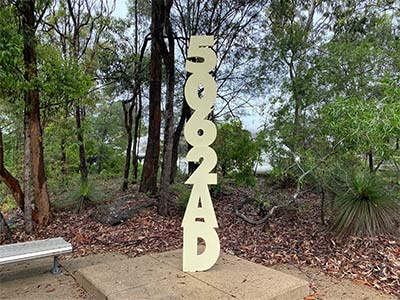
All the time in the world
Scott Redford
1996
Powdercoated steel, sculpture
Purchased in 1996
Griffith University Art Collection
Scott Redford established a national reputation as an artist in the 1980s by combining an interest in the commercialized surf and tourist culture of Queensland's Gold Coast (where he was born and lived for the first part of his career) and an astute awareness of modernist art history. Many of his works that appear to be lifted directly from the popular imagery of consumer society are in fact steeped in references to earlier art, particularly in Europe and the U.S.
This sculpture, commissioned for the Nathan campus of Griffith University, may be regarded as a purely abstract work in the tradition of the columns made by twentieth century Romanian sculptor Constantin Brancusi. It makes more specific references to projects by the U.S. pop artists Robert Indiana and Claes Oldenburg, both of whom presented language on a large scale in three dimensions. It also recalls the graphics of advertising. The sculpture was fabricated to the artist's specifications, and this commercial/industrial approach to art making is an essential part of the work's significance. It is intended to have the character of a manufactured commodity rather than a handmade art object.
There is no significance in the year 5062AD. The use of arbitrary selection recurs throughout Redford's works, and reflects a wish to make art that is about expressive detachment, and resists facile interpretation. The date is so far into the future as to be unimaginable and therefore hypothetical. Treating the future as an unreal, abstract notion contributes the idea of ephemerality in his work, even in a physically durable piece like this.
The opinions expressed by artists, researchers, student interns and commissioned writers as part of the GUAC on-line catalogue do not necessarily reflect those held by Griffith Artworks or Griffith University, but evidence the rights of individuals to conduct research and engage in rigorous critique for educational purposes.